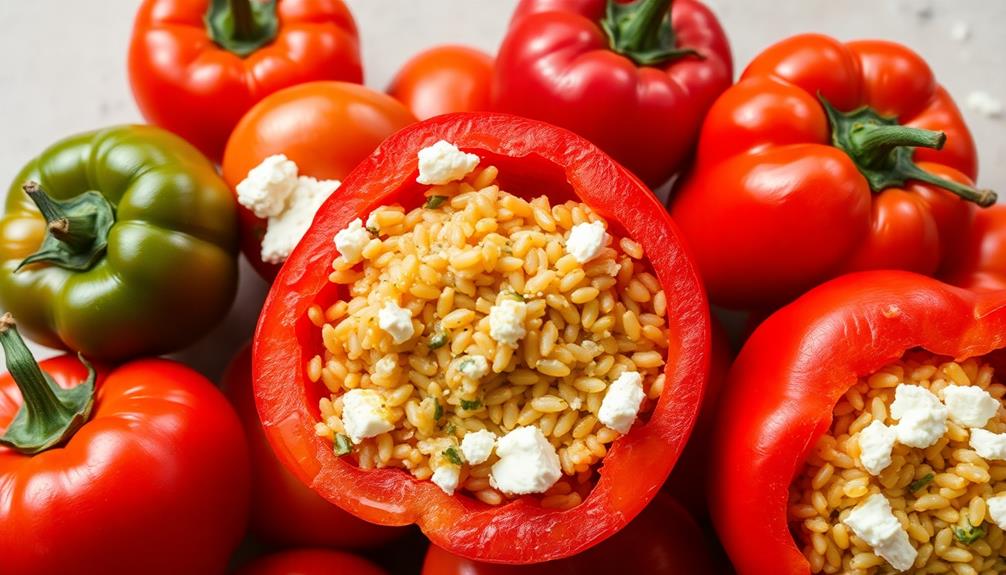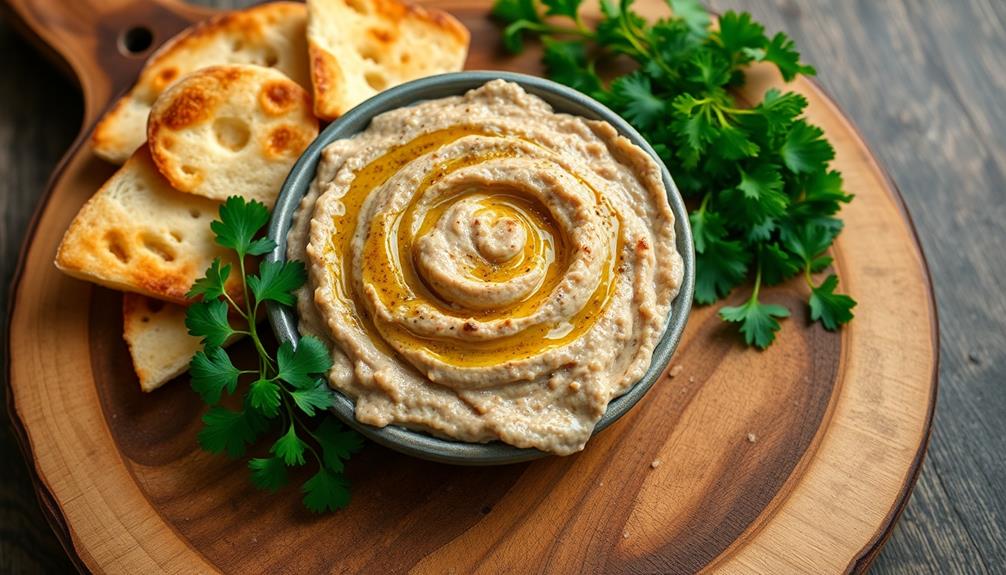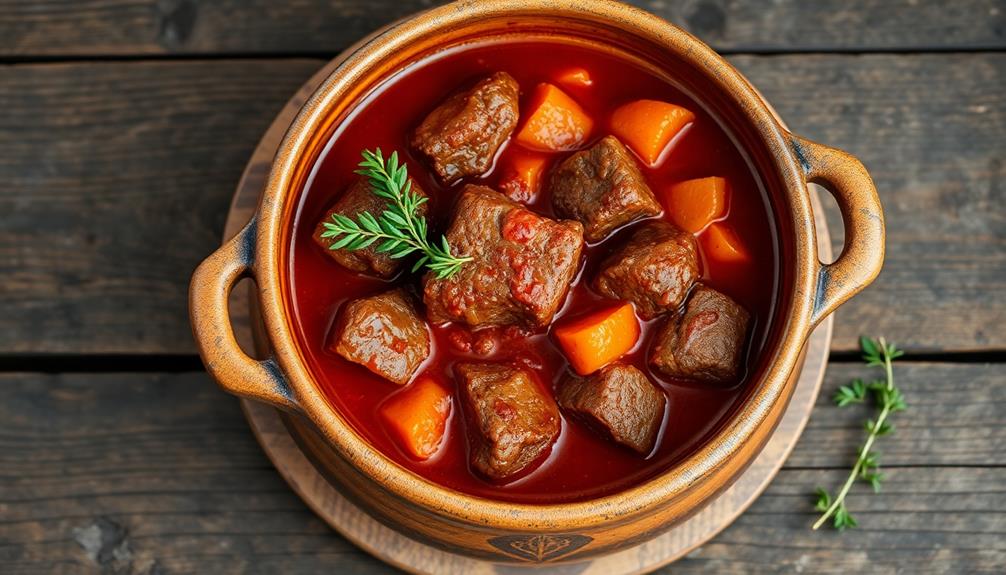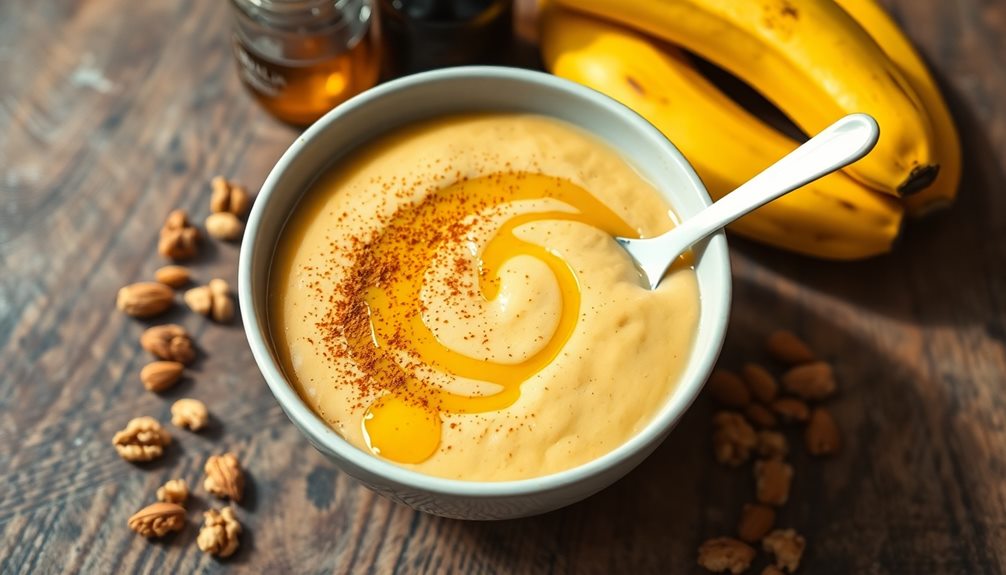Gemista, a classic Greek dish, invites you on a delightful culinary journey through sun-drenched Mediterranean flavors. These stuffed vegetables, often tomatoes and peppers, showcase a flavorful rice-based filling that's been perfected over generations. The vibrant, aromatic ingredients create a harmonious balance of textures and tastes, tantalizing your palate with each bite. Gemista celebrates the use of fresh, seasonal produce, reflecting Greece's diverse gastronomic heritage. As you savor the tender roasted vegetables and rich flavors, you'll be eager to learn more about this beloved dish and the cultural traditions it embodies.
Key Takeaways
- Gemista is a classic Greek dish featuring stuffed vegetables, primarily tomatoes and peppers, with a flavorful rice-based filling.
- The dish has roots in the culinary traditions of Greece and reflects the region's diverse gastronomic heritage and use of fresh, seasonal ingredients.
- Preparation involves hollowing out the vegetables, blanching them, and then stuffing them tightly with the rice mixture before baking until tender and golden.
- Gemista is a versatile and adaptable dish that allows for experimentation with different vegetable varieties and customization of the filling to individual preferences.
- Serving gemista hot and garnished enhances the presentation and creates a memorable culinary experience that celebrates the flavors of the Mediterranean.
History
Gemista, the beloved Greek dish, has its roots deeply embedded in the country's rich culinary traditions. For centuries, the art of stuffing vegetables with a savory mixture has been passed down through generations, each family adding their own unique twist to the recipe.
You can almost feel the history in every bite, as the flavors of the land come together in perfect harmony. The word "gemista" itself means "stuffed" in Greek, a nod to the centuries-old technique of filling vegetables like tomatoes, peppers, and zucchini with a delectable blend of rice, herbs, and aromatic spices.
This quintessential dish has evolved over time, with regional variations and personal preferences shaping its development. From the sun-drenched islands to the mountainous regions, gemista has become a culinary touchstone, uniting Greek communities and celebrating the country's diverse gastronomic heritage.
Recipe
Gemista is a classic Greek dish that features stuffed vegetables, typically tomatoes and peppers, with a flavorful rice-based filling. This dish isn't only delicious but also a wonderful way to showcase the bounty of seasonal produce.
The key to a successful Gemista lies in the balance of flavors and textures. The filling, made with a combination of rice, herbs, and aromatic vegetables, complements the natural sweetness of the hollowed-out vegetables. The result is a hearty and satisfying meal that's perfect for sharing with family and friends.
Ingredients:
- 6-8 tomatoes
- 4-6 bell peppers
- 1 cup long-grain rice
- 1 onion, finely chopped
- 3 cloves garlic, minced
- 1 cup crumbled feta cheese
- 1/2 cup fresh parsley, chopped
- 2 tablespoons fresh mint, chopped
- 1 teaspoon dried oregano
- Salt and pepper to taste
- Olive oil for drizzling
Cooking Instructions:
In a large pot, bring salted water to a boil. Carefully slice the tops off the tomatoes and peppers, and scoop out the seeds and pulp, reserving the pulp. In the boiling water, blanch the tomatoes and peppers for 2-3 minutes to soften them slightly. Remove and set aside to cool.
In a saucepan, cook the rice according to package instructions. In a skillet, sauté the onion and garlic until fragrant and translucent. Add the reserved tomato pulp, feta, parsley, mint, and oregano. Season with salt and pepper. Stir in the cooked rice and mix well.
Stuff the hollowed-out tomatoes and peppers with the rice filling, pressing gently to compact it. Place the stuffed vegetables in a baking dish, drizzle with olive oil, and bake at 375°F (190°C) for 45-60 minutes, or until the vegetables are tender and the filling is hot and bubbly.
Tips:
For best results, use fresh, ripe tomatoes and peppers. The filling can be prepared in advance and refrigerated until ready to assemble and bake. Serve the Gemista warm, garnished with additional herbs or crumbled feta if desired. Enjoy this delightful Greek dish!
Cooking Steps
First, prepare the vegetables by carefully hollowing them out, leaving just enough flesh to maintain their shape.
Next, stuff the vegetable cavities with a savory filling, packing it in tightly.
Then, bake the stuffed veggies until they're tender and the top is golden brown, basting them periodically to keep them moist.
Step 1. Prepare the Vegetables
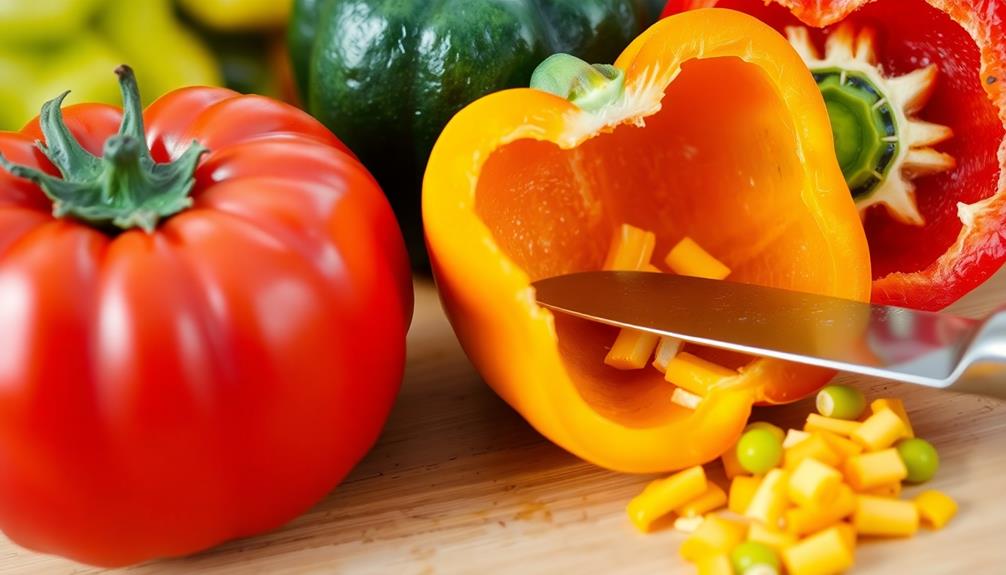
Preparing the vegetables is the next step in crafting the delectable Gemista dish. Begin by thoroughly washing the tomatoes, peppers, and any other vegetables you've selected. Carefully slice the tops off the tomatoes and peppers, reserving them for later use. Scoop out the insides of the tomatoes and peppers, being cautious not to tear the outer shells.
Dice the tomato pulp and pepper innards, setting them aside in a bowl. This tasty mixture will be combined with the rice filling later on.
Next, use a spoon to gently hollow out the zucchini and eggplant, leaving about a 1/2 inch of flesh intact. Chop the removed zucchini and eggplant pieces into small cubes and add them to the tomato and pepper mixture.
This colorful, aromatic blend of diced vegetables will infuse the Gemista with exceptional flavor. With the prep work complete, you're ready to start assembling the stuffed veggie masterpieces. After stuffing the vegetables with the aromatic blend, the next step is to add a generous drizzle of olive oil and a sprinkle of salt and pepper. Then, they are ready to be baked to perfection. In addition to the exceptional flavor, the benefits of horta for health make this dish a nutritious and delicious option for any meal. With the abundance of vitamins, minerals, and antioxidants found in the diced vegetables, this Gemista is not only flavorful but also provides a nourishing meal for the body.
Step 2. Stuff the Vegetable Cavities
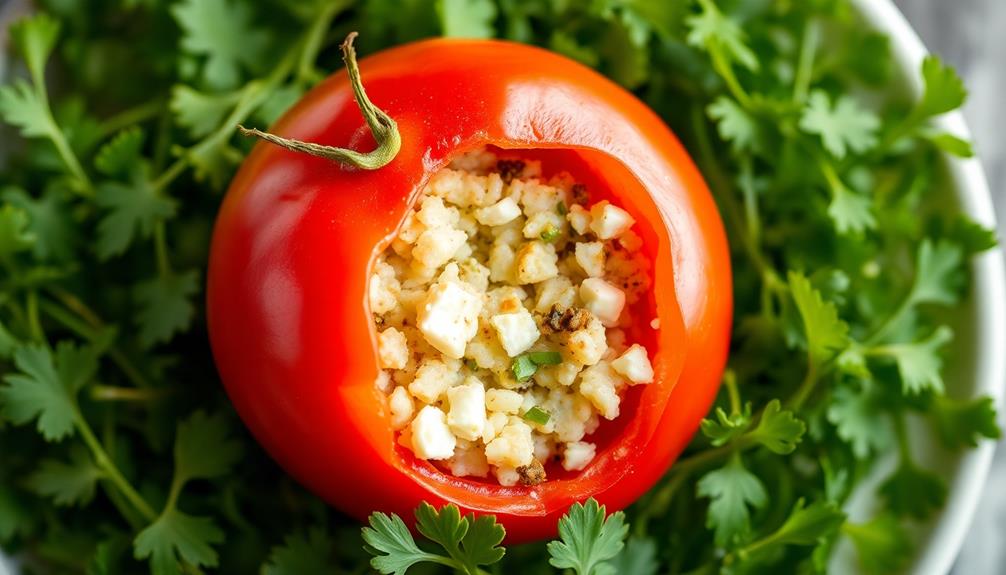
With the vegetable prep work complete, it's time to start stuffing the cavities. Grab a spoonful of the savory rice filling and gently pack it into the hollowed-out pepper, tomato, or zucchini.
Be sure to fill the cavity all the way to the top, pressing down lightly to compact the filling. As you work, visualize the flavors melding together – the herbaceous notes of the parsley, the earthy warmth of the cinnamon, the bright acidity of the tomatoes.
With each vegetable you stuff, you're creating a delectable vessel to hold all those delicious Mediterranean flavors. Don't be afraid to get your hands a little messy – the process is all part of the fun!
Once the cavities are filled, arrange the stuffed veggies in a baking dish, ready to be roasted to perfection. Get ready for your kitchen to be filled with the mouthwatering aroma of this classic Greek dish.
Step 3. Bake the Stuffed Vegetables
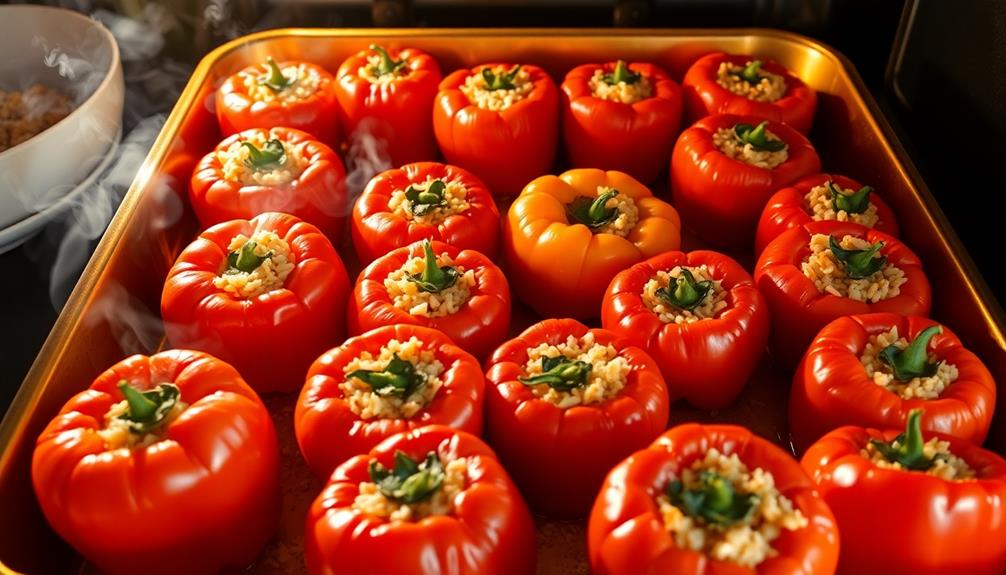
Preheat your oven to 375°F (190°C). Once your oven is ready, carefully place the stuffed vegetables into a large baking dish. Make sure they're snug and touching each other, so they support one another as they bake.
Drizzle a generous amount of olive oil over the top, ensuring every nook and cranny is coated. This will help the vegetables achieve a beautifully golden-brown color as they roast.
Next, pour in about 1 cup (240 ml) of water or broth around the base of the dish. This will create a flavorful steaming environment, keeping the filling moist and tender.
Cover the dish tightly with aluminum foil, sealing the edges to lock in the moisture. Bake the stuffed vegetables for 45-60 minutes, or until they're fork-tender and the filling is piping hot.
Remove the foil during the last 10 minutes of cooking to allow the tops to crisp up. Serve the gemista warm, garnished with fresh herbs for a vibrant finishing touch.
Step 4. Baste the Stuffed Vegetables
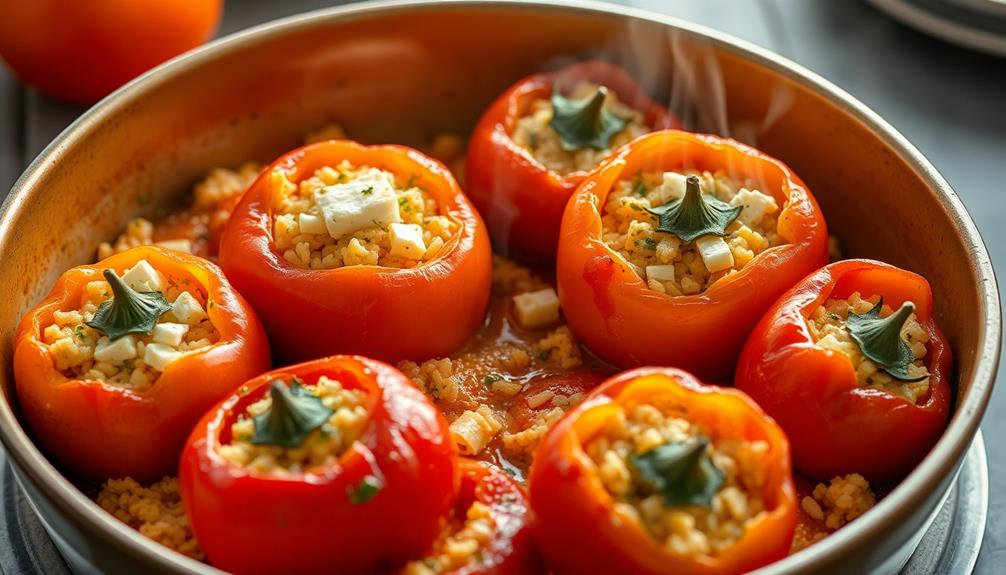
As the gemista bake, keep a close eye on them. Every 15 minutes or so, open the oven and use a spoon to carefully baste the vegetables with the savory juices that have accumulated in the baking dish.
This process helps the vegetables stay moist and flavorful as they cook. Gently spoon the liquid over the tops of the stuffed peppers and tomatoes, making sure to reach the sides as well. The basting liquid will soak into the rice and herb filling, infusing it with even more delicious taste.
Be gentle, as you don't want to disturb the delicate stuffing. Continue this basting routine until the gemista are fork-tender and the tops are lightly browned, about 1 to 1.5 hours total. The aroma filling your kitchen will have your mouth watering in anticipation.
Once they're ready, remove the baking dish from the oven and let the gemista rest for 5-10 minutes before serving. Enjoy!
Step 5. Serve Hot and Garnished
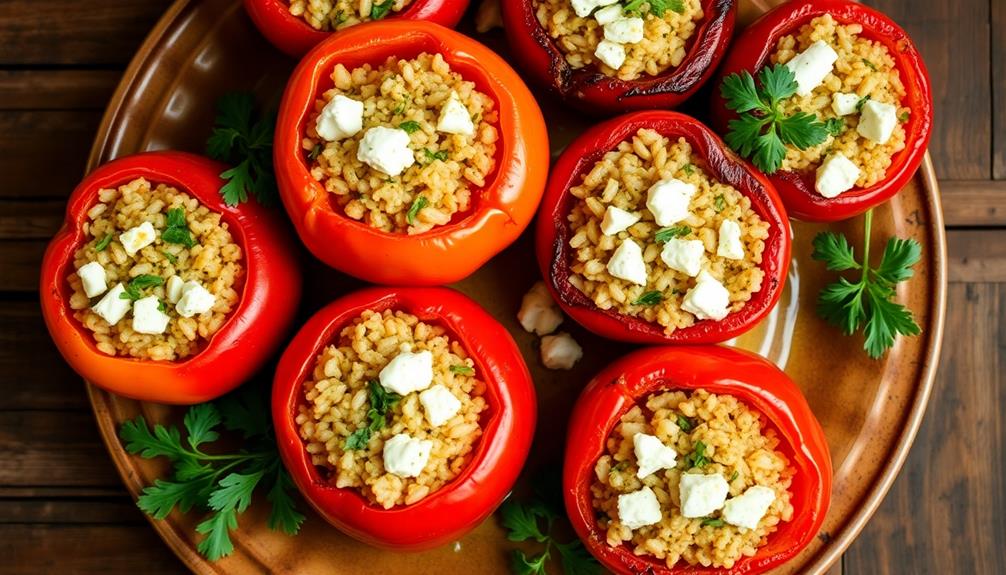
Once the gemista have finished baking, it's time to serve them hot and garnished. Carefully remove the baking dish from the oven, being mindful of the steam. Use oven mitts to transfer the golden-brown, aromatic vegetables onto a serving platter.
The vibrant colors of the stuffed tomatoes, peppers, and zucchini will be a delight to behold. Arrange the gemista in an attractive display, allowing the filling to peek out invitingly. Drizzle the vegetables with the flavorful juices from the baking dish, ensuring each one is glistening and moist.
Garnish the platter with fresh herbs, such as fragrant oregano or basil, adding a pop of green and elevating the dish's presentation. Serve the gemista immediately, while they're piping hot.
Encourage your guests to savor the tender texture of the roasted veggies and the rich, savory flavors of the filling. Pair the gemista with crusty bread or a light salad for a complete and satisfying meal.
Final Thoughts
Ultimately, gemista make for a delightful and versatile Mediterranean dish. These vibrant, stuffed vegetables are a true delight for the senses, both visually and gastromatically. The perfect blend of flavorful fillings, tender vegetables, and aromatic herbs creates a harmonious symphony that tantalizes the palate.
Whether you're serving them as a main course or a side, gemista are sure to impress your guests and leave them craving more.
The beauty of gemista lies in their adaptability. You can experiment with different vegetable varieties, fillings, and seasonings to suit your preferences and the ingredients you have on hand.
This makes gemista an excellent choice for both everyday meals and special occasions. As you savor each bite, you'll be transported to the sun-drenched shores of the Mediterranean, where the flavors of this beloved dish have been perfected over generations.
Frequently Asked Questions
What Is the Difference Between Gemista and Dolmades?
Gemista and dolmades are both stuffed vegetable dishes, but they differ in their fillings. While gemista are stuffed with rice, herbs, and tomatoes, dolmades are grape leaves stuffed with a mixture of rice, herbs, and sometimes ground meat.
How Long Do the Stuffed Vegetables Typically Last?
Stuffed vegetables typically last 3-5 days when refrigerated in an airtight container. The exact shelf life can vary depending on the specific ingredients used and how they're prepared. With proper storage, you can enjoy them for several days after making.
Can the Filling Be Prepared in Advance?
You can prepare the filling in advance. Just refrigerate it in an airtight container until you're ready to stuff the vegetables. This makes the cooking process quicker and more convenient on the day you plan to serve the dish.
Are There Any Variations on the Traditional Recipe?
Yes, there are several variations on the traditional recipe. You can use different types of vegetables, play with the seasonings, and even incorporate meats or cheeses into the filling for a unique twist.
Can Gemista Be Frozen and Reheated?
Yes, you can freeze and reheat gemista. The stuffed veggies hold up well to freezing, and reheating them is a breeze. Just make sure to thaw them in the fridge before popping them in the oven.
